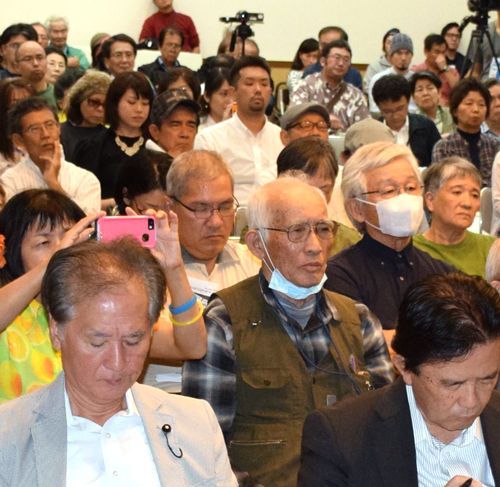Naha symposium addresses dangers facing Yambaru from U.S. military in Takae, Henoko, Ie-jima

Attendees of the symposium listening intently to speakers’ statements on November 26.
November 27, 2016 Ryukyu Shimpo
On the evening of November 26, at a youth assembly hall (Okinawa-ken Seinenkaikan Horu) in Naha City, an Okinawan group opposing military base relocation within Okinawa held an urgent symposium on protecting the whole of Yambaru from becoming a danger zone in the Ie-jime, Takae, and Henoko triangle. Two hundred and fifty people attended the symposium. During the panel discussion problems such as helipad construction, Henoko base construction, and Ie-jima landing strip extension were examined from various angles, including construction illegality and environmental destruction.
In regards to helipad construction in Takae, biologist Masako Yafuso explained that there is no established method to restore the subtropical nature that has been destroyed. She said that the important thing now is to halt construction, even if only for a minute.
Tsuyoshi Kitaueda, a member of the Peace Citizens’ Liaison Committee, showed understanding for the Prefectural Government’s acceptance of resumed construction on Camp Schwab barracks. However, he said that for base construction in Henoko 56,000 tetrapods (wave-dissipating concrete blocks) would be necessary, and a concrete plant will be built in order to produce these. He emphasized, “[The concrete plant is] separate of barracks construction, and we will absolutely not allow it to be built.”
Yoshikazu Makishi, an architect, showed concern about resumed construction on the barracks. Mentioning a plan for ten-odd barrack buildings to be constructed in the vicinity of Henoko Dam, he went on to point out the overall importance of forcing the Japanese government to stop the construction itself.
Journalist Tomohiro Yara said that Japan should cooperate with American think tanks based in Washington, D.C., start negotiations with the U.S. by suggesting that the U.S. military could make progress in the Asia-Pacific region without putting Marines in Okinawa.
Minoru Naka of the Ie Village Council was present at the symposium, and hurriedly went onstage to give a report on the effects and other matters related to landing strip extension at Ie-jima Auxiliary Airfield.
(English translation by T&CT and Erin Jones)
Previous Article:Governor suggests reluctant acceptance of helipad construction, remains opposed to Osprey
Next Article:Hyakuna Garan receives three international awards for hotel service
[Similar Articles]
- Government starts building concrete plant at Henoko, Okinawa concerned it will be used for land reclamation
- Takae residents protest against Japanese government agreeing to provide land for US helipads before returning region’s land occupied by US military
- Eight nuns from Tokyo and Miyazaki Prefecture take part in protest against Henoko
- US military carries out Osprey training at new helipad in Takae for the first time
- “Drowns out the TV”: Residents share Takae updates on YouTube, including U.S. military noise pollution and waste
 Webcam(Kokusai Street)
Webcam(Kokusai Street)


